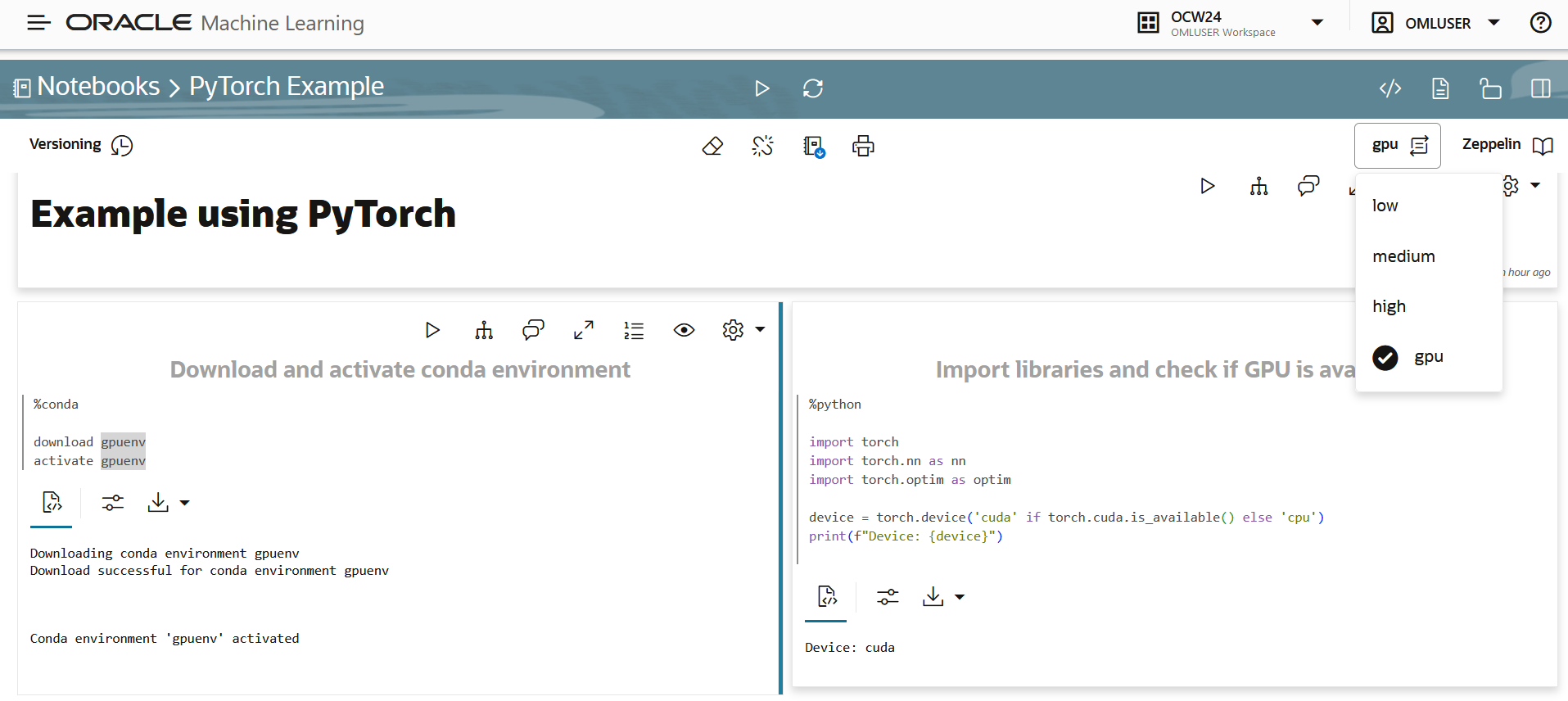We are pleased to announce that Autonomous Database Serverless now provides integrated access to OCI GPU (Graphical Processing Unit) instances through Oracle Machine Learning (OML) Notebooks. Python users can now easily activate GPU resources at the individual notebook level and leverage GPU-enabled Python packages. This feature supports the use of GPUs for compute-intensive tasks on Oracle Autonomous Database Serverless with Oracle Database 23ai.
In this initial release, you can develop Python code using the OML Notebooks Python interpreter for use cases requiring the performance and scalability of GPUs. GPU-enabled packages can be transparently offloaded to OCI instances to help accelerate batch vector embedding generation for AI Vector Search, build deep learning models, and do inferencing in batch.
Importance of GPUs
GPUs excel at parallel processing for compute-intensive tasks, including AI embedding models, deep learning modeling, and inferencing. GPUs can dramatically enhance performance for a variety of use cases.
GPUs can be cost-effective for compute-intensive tasks by enabling higher performance without proportionally higher hardware costs.
Benefits of GPUs on Autonomous Database
With this announcement, Autonomous Database Serverless enables Python users to take advantage of the performance and scalability offered by NVIDIA GPUs using Python libraries that are GPU-enabled. We help make GPU access on Autonomous Database Serverless convenient and simple for both data scientists and developers by letting them seamlessly activate GPU resources in a single action by selecting the notebook service level as ‘gpu’. This automatically provisions a GPU VM that can run workloads using GPU-enabled Python packages along with non-GPU (i.e., CPU) workloads.

Figure 1: Oracle Machine Learning Notebooks editor showing selected ‘gpu’ notebook type to enable GPU resources for Python paragraphs.
By creating custom conda environments, users have access to GPU-enabled packages required for specific projects.
Enabling GPUs on Autonomous Database with OML
To enable GPUs on Autonomous Database through OML Notebooks, take the following steps:
- The ADMIN user creates your custom conda environment.
- Create or open your notebook and change the notebook type (service level) to ‘gpu’.
- Download and activate your conda environment before running Python code.
- Code that uses functionality from GPU-enabled packages will see the benefits of GPUs.
Note that using GPUs requires a paid account with the Oracle Machine Learning application ECPU allocation set to 16 or greater. GPUs resources are charged per Oracle Autonomous Database Serverless Billing for Database Tools.
Our roadmap for Autonomous Database GPU enablement includes several features:
- OML4Py Embedded Python Execution: GPU support on Autonomous Database Serverless will expand to include OML4Py Embedded Python Execution, where you can run user-defined functions in database spawned and managed Python engines from SQL and REST APIs. These user-defined functions can leverage the same conda environments as in notebooks. This feature supports production deployment of Python code in applications using SQL and REST APIs.
- OML4Py Spatial AI: New spatial machine learning algorithms were added to OML4Py in Oracle Database 23ai. With the introduction of GPUs, spatial deep learning algorithms will support an even broader range of use cases powered by GPUs, e.g., object detection/identifying, classification, segmentation, change detection using satellite imagery and point cloud data.
- ONNX-format models GPU offload: For ONNX-format models imported into the database, OML4Py will support using GPUs for the ONNX Runtime when performing batch scoring. This includes embedding, classification, regression, and clustering models.
- Multiple GPU chip options: Take advantage of different GPU chips available within your region.
Try it today!
Using your paid Autonomous Database (ADW, ATP) instance with Oracle Database 23ai, create your conda environment with GPU-enabled packages and enable your notebook to use GPU resources. See the resources shown below for more details.
Resources
OML Notebooks support for GPUs
Oracle Machine Learning Notebooks
Oracle Machine Learning
Oracle Machine Learning Fundamentals LiveLab
Future Product Disclaimer
The preceding is intended to outline our general product direction. It is intended for information purposes only, and may not be incorporated into any contract. It is not a commitment to deliver any material, code, or functionality, and should not be relied upon in making purchasing decisions. The development, release, timing, and pricing of any features or functionality described for Oracle’s products may change and remains at the sole discretion of Oracle Corporation.
